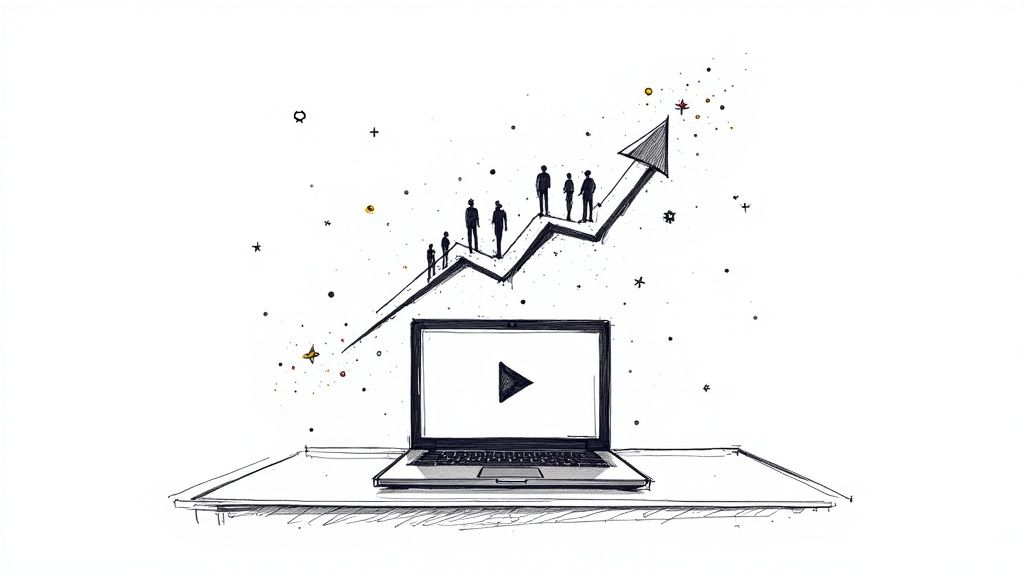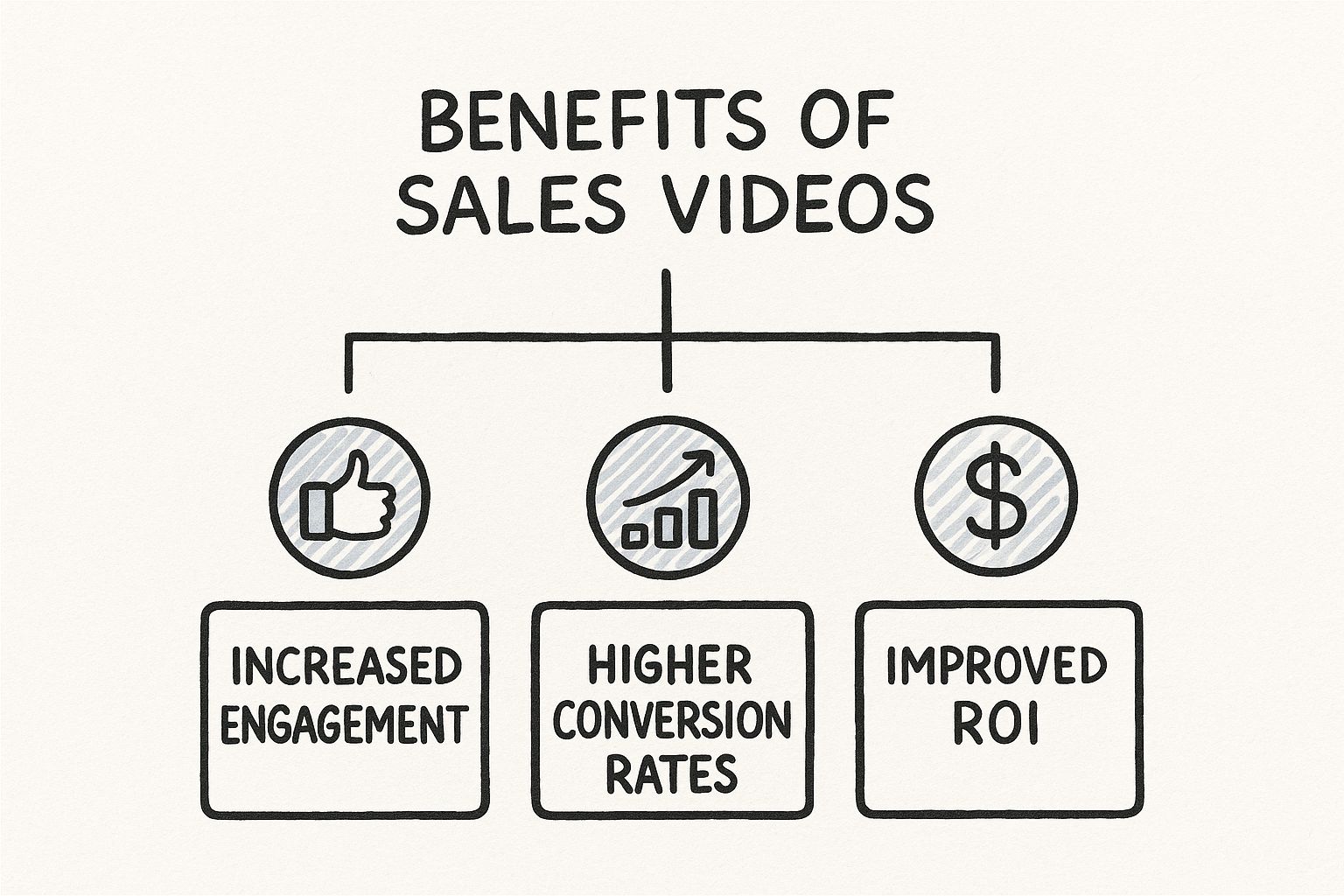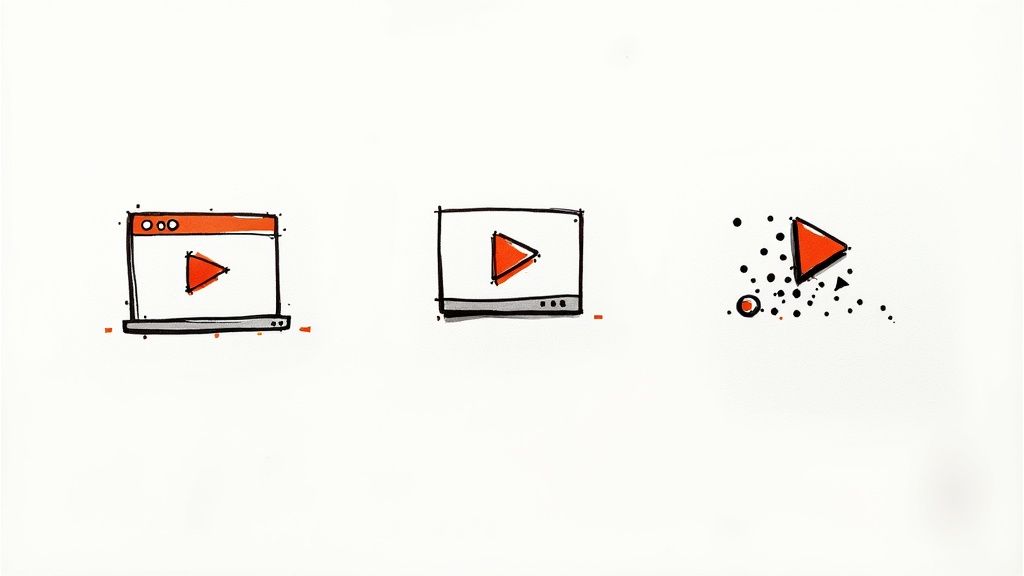
Video for Sales: Proven Strategies to Boost Conversions
Let's be honest, in a world drowning in text, video for sales is the lifeline that pulls you through the noise. It’s not about just hitting ‘record’; it’s about forging a genuine, face-to-face connection that builds trust and gets deals done faster. Think of it as the next best thing to actually being in the room with your prospect.
Why Video Is Redefining Modern Sales

Think about the difference between a picture and a movie. The picture captures a single moment, but a movie tells a story, sparks emotion, and holds your attention. That’s the exact leap in connection you get when you use a video for sales instead of old-school, text-heavy emails.
We all know the feeling. Inboxes are overflowing, and prospects have become masters at tuning out generic templates. A wall of text is easy to ignore, but a friendly face in a personalized video? That’s almost impossible to scroll past. It immediately stands out and puts a human being back into the sales process, right from the very first touchpoint.
This simple shift turns your outreach from a one-way shout into a two-way conversation before you even speak. When a prospect can see and hear you, they pick up on your sincerity and personality, building the kind of rapport that would normally take a long chain of emails to establish.
Building Trust at Scale
Trust is the currency of sales. While nothing can perfectly replicate a handshake and a meeting, personalized video gets incredibly close. It lets you bring the most important parts of a face-to-face chat to the screen:
- Visual Cues: Your smile and body language instantly convey warmth and authenticity.
- Vocal Tone: The way you speak adds a layer of meaning and personality that text just can't touch.
- Personalization: Simply using the prospect’s name, mentioning their company, or referencing a specific pain point shows you’ve done your research.
A personalized video shows you put in the effort and have a genuine interest in their business. That small act of caring is a massive differentiator. It builds credibility and makes prospects feel valued, not just like another name on a list.
Accelerating the Sales Cycle
The benefits of using video for sales don't stop at just getting a reply; they have a real impact on your bottom line. The data doesn't lie—video isn't just a fluffy marketing tactic, it's a serious sales driver.
Consider this: 87% of marketers directly attribute an increase in sales to their video efforts, and 86% confirm that video is a powerful tool for generating leads. With numbers like that, it's no shock that a massive 90% of marketers report a positive ROI from video. You can dig into more of the latest industry reports to see the full picture.
This all points to one undeniable conclusion: video isn't a "nice-to-have" anymore. It’s a core piece of any modern sales strategy. By weaving it into your outreach, demos, and follow-ups, you create a sales process that’s more engaging, more efficient, and ultimately, more profitable. It’s a must-have for any sales pro serious about building stronger relationships and closing more deals.
Choosing the Right Video for Any Sales Scenario
Not all sales scenarios are created equal, and your videos shouldn't be either. Sending the wrong type of video at the wrong time is like trying to use a hammer to turn a screw—it’s just the wrong tool for the job. The real secret to success with video for sales is knowing which video to send at which point in the customer's journey.
Think of your videos as a specialized toolkit. You’ve got different instruments for specific tasks, whether you're trying to crack open a cold lead or close a complex deal. A quick, informal selfie video might be perfect for that first "hello," but you'll need a polished product demo to push a qualified lead toward a decision. It’s all about context.
When you get this right, your message doesn't just land; it resonates. You guide the prospect smoothly from one stage to the next.

As you can see, using video the right way creates a positive domino effect. It starts with grabbing your viewer's attention, which naturally leads to better conversion rates and, ultimately, a much healthier return on your efforts.
To make this even clearer, let's break down which videos work best at each stage of the sales funnel. This table maps out the most effective video types, their primary goal, and how you should measure success along the way.
Matching Video Types to Sales Funnel Stages
By aligning your video strategy with this framework, you're not just sending videos—you're having a strategic conversation that moves deals forward.
H3: Top of the Funnel: Making a Human Connection
At the top of the funnel (ToFu), your job is simple: get noticed and spark some interest. These prospects might not even realize they have a problem you can solve yet. Your videos need to be short, personal, and laser-focused on making a genuine human connection.
The absolute champion here is the personalized prospecting video. We're not talking about a big-budget production. This is often a simple screen recording where you greet the prospect by name, maybe pull up their LinkedIn profile or company website, and drop a quick, compelling message in under 60 seconds.
- Goal: Cut through the inbox clutter and earn a reply or a meeting.
- Best For: Cold outreach and waking up dormant leads.
- Why It Works: It’s undeniable proof that you're not a spambot and that you've put real thought into reaching out to them specifically.
A personalized video at this stage is the digital equivalent of a firm handshake and a warm smile. It instantly cuts through the cold, text-based noise and starts building a real relationship.
H3: Middle of the Funnel: Building Value and Trust
Once you’ve got their attention, the game changes. Now, it's all about education and proving your value. Prospects in the middle of the funnel (MoFu) are actively looking for solutions. Your videos need to answer their questions, proactively address objections, and show them exactly how your solution works in the real world.
Your go-to formats here are product demo videos and case study videos. A great demo video isn't just a feature tour; it's a guided walkthrough that directly connects your product's capabilities to the specific pain points they've shared with you.
Case study videos, on the other hand, are your secret weapon for building trust. There’s nothing more powerful than social proof. When a prospect hears a happy customer—someone just like them—talk about their success, it makes the decision to move forward feel a whole lot safer.
H3: Bottom of the Funnel: Closing the Deal
At the bottom of the funnel (BoFu), your prospect is on the verge of a decision. They’re likely weighing you against a competitor and just need that last bit of reassurance. Videos at this stage should feel highly personal and aim to remove any final ounce of friction.
Here are a few powerhouse video types for the final stretch:
- Proposal Walk-Throughs: Don't just email a dry contract and hope for the best. Record a short video walking them through the key terms, reminding them of the value, and clearly outlining the next steps. It adds a personal touch and preempts confusion.
- Team Introduction Videos: Introduce the implementation or customer success team they'll be working with after they sign. This simple gesture makes the handoff feel seamless and shows you're committed to their long-term success.
- Personalized Thank-You Videos: Once the deal is signed, a quick "thank you" video from you or a team leader is the perfect way to kick off the partnership. It reinforces their decision and starts the relationship on an incredibly positive note.
Choosing the right video for sales isn't random; it's a strategic move. When you align your video type with where your prospect is in their journey, you create a more persuasive, effective, and human-centered sales process.
Creating Sales Videos That Actually Convert

Knowing what kind of video to make is only half the puzzle. The other half is figuring out how to create one that actually grabs someone's attention and makes them want to act.
The good news? You don't need a Hollywood budget or a full film crew to make a powerful video for sales. Honestly, a genuine, clear message almost always beats a slick, impersonal production. The goal isn't to win an Oscar; it's to build a real connection and nudge your prospect toward the next step.
If you focus on a few core ideas, you can easily produce videos that look and sound professional enough to drive serious results.
Start With a Simple Script
Before you even think about hitting that record button, take a minute to sketch out what you plan to say. Just "winging it" is a recipe for a rambling, unfocused video that will have your viewer tuning out in seconds. A simple script keeps you on track and makes sure your message lands with clarity and impact.
This doesn't need to be a word-for-word manuscript. A basic three-part outline is usually all you need:
- The Hook: Kick things off by addressing your prospect by name and mentioning something specific to them. Maybe it's a recent LinkedIn post they shared, a company announcement, or a pain point you've picked up on. This instantly shows them this video was made just for them.
- The Value: This is the heart of your message. Get straight to the point and explain why you're reaching out. Connect their problem directly to your solution with one single, compelling idea. Resist the urge to list every feature; just focus on the one benefit that will hit home.
- The Ask: Wrap it up with a clear and direct call-to-action (CTA). Don't leave them hanging or wondering what you want them to do next.
This simple framework gives you enough structure to stay focused but leaves plenty of room for your personality to come through.
Nail the Technical Basics
You don't need fancy gear, but terrible audio or bad lighting can be so distracting that your message gets completely lost. Getting these two things right makes a massive difference in how professional your video feels.
For Clear Audio:
Your computer’s built-in mic usually isn't going to cut it. It picks up all sorts of background noise and echo, making you sound like you're in a cave. A simple lapel mic or an affordable USB microphone will make you sound crisp and clear.
For Good Lighting:
No need for a complicated lighting setup here. The cheapest and easiest trick is to just face a window. Natural light is soft and looks great on camera. If that's not an option, a basic ring light positioned behind your camera will light up your face and create a clean, professional look. The golden rule is to always have the light source in front of you, never behind.
Authenticity is your greatest asset. Prospects respond to a genuine, human connection, not a perfectly polished, corporate-style production. Focus on being yourself and delivering a clear, valuable message.
Keep It Short and Sweet
Let's be real, attention spans are fleeting. Research shows that viewer engagement drops off a cliff after the first minute. For most sales videos, especially for prospecting, you should aim for a length of 60 to 90 seconds.
That’s just enough time to land your hook, deliver your value, and make your ask without overstaying your welcome. It shows you respect their time, which is something every busy professional appreciates.
Craft a Compelling Call-to-Action
A video without a CTA is a total missed opportunity. It’s like telling a great story and then just walking away before the punchline. Your CTA needs to be specific, easy, and low-friction.
Instead of a weak "let me know what you think," try something more direct:
- "Click the link below to grab a 15-minute spot on my calendar that works for you."
- "Just reply to this email with a 'yes' if you'd like me to send over that case study I mentioned."
- "What's the best way to get a brief chat on your schedule for next week?"
The power of video marketing is impossible to ignore, and the money follows. Global spending on video ads is on track to blow past $190 billion in 2025. Why? Because brands have seen that video can boost conversion rates by up to 12 times, directly fueling a higher ROI. For companies that need a hand producing top-notch sales videos, looking into professional creative services for video production can be a game-changer.
How Interactive Video Transforms the Sales Process
Traditional sales video is a powerful one-way broadcast, but what if you could turn that broadcast into a two-way conversation? This is where the real transformation begins. Interactive video flips the script by inviting your prospect to participate, turning them from a passive observer into an active collaborator in their own buying journey.
Instead of just sitting through a static product demo, imagine a prospect clicking on the features that matter most to them, answering questions that clarify their needs, and even booking a meeting—all without ever leaving the video player. This isn’t some far-off concept; it’s what you can do right now with interactive video platforms like Mindstamp. It's the difference between giving a lecture and hosting a dynamic, hands-on workshop.
By embedding interactive elements directly into your sales videos, you create an experience that is both genuinely engaging and incredibly data-rich. You’re not just hoping your message lands; you’re actively guiding the conversation and collecting priceless feedback in real time.
From Passive Views to Active Engagement
The true power of interactive video is its ability to demand a response. When a prospect has to click, choose, or type, they become cognitively invested in what they're watching. This deepens their engagement and dramatically increases how much information they remember.
Here are a few of the key interactive features you can start using:
- Clickable Buttons & Hotspots: Let viewers click on specific parts of the screen to learn more, download a resource, or visit a relevant webpage. In a product demo, a prospect could click on different features to get a quick, detailed explanation of each one.
- In-Video Questions: Ask multiple-choice or open-ended questions to gauge understanding, qualify their needs, or simply gather feedback. This turns a simple video into a powerful qualification tool.
- Lead Capture Forms: Why wait until the end? Embed a form directly within the video to capture a prospect's information at the exact moment their interest is highest.
- Conditional Logic (Branching): This is a true game-changer. Based on a viewer’s answer to a question, you can automatically send them to a different part of the video that’s most relevant to their specific needs or interests.
This level of interactivity creates a personalized "choose your own adventure" experience for every prospect. It makes your sales content feel less like a generic pitch and more like a personal consultation.
A Real-World Scenario in Action
Let’s see how this works in practice. Imagine a sales rep named Sarah sends a prospect an interactive product demo she built with Mindstamp.
Instead of a standard five-minute video, Sarah’s demo kicks off with a simple question: "What is your biggest challenge right now: increasing efficiency, reducing costs, or improving team collaboration?" When the prospect clicks "reducing costs," the video instantly jumps to a section showcasing the product's ROI-driving features, complete with a customer testimonial about cost savings.
Later, a button appears: "Want to see how this integrates with your current software?" If the prospect clicks yes, they see a brief integration guide. If they click no, the video skips that part entirely. Finally, a lead form pops up asking for their email to receive a personalized pricing quote.
Sarah now has a treasure trove of data. She doesn't just know the prospect watched the video; she knows their main pain point is cost, they’re interested in integrations, and they requested a quote. Her follow-up can be hyper-specific and incredibly relevant.
This screenshot shows just how you can layer various interactive elements onto a single video, creating multiple pathways for a viewer.
Each button, question, or hotspot is an opportunity to learn more about your prospect's intent and guide them more effectively toward a solution.
The adoption of video as a core business tool is no longer an emerging trend—it's the standard. Recent findings show that by 2025, an incredible 89% of businesses globally will use video as a marketing tool. On top of that, 95% of video marketers say it's a vital part of their strategy, and for good reason: 93% of marketers report a positive ROI from their video efforts. You can dig into the full report on the growing impact of video marketing to see the data for yourself.
Turning Video Views into Rich Data
With a standard video, your main metrics are usually "view count" or "watch time." While helpful, they don't tell you what the viewer was thinking or which parts of your message actually resonated.
Interactive video analytics, like those in Mindstamp, give you a much deeper story. You can track:
- Which buttons were clicked most often, revealing the most compelling parts of your pitch.
- How viewers answered qualification questions, allowing you to segment leads automatically.
- Where viewers dropped off, showing you which parts of your video might be losing their attention.
This data transforms your video for sales from a simple communication tool into a powerful intelligence-gathering machine. For a deeper look at how this works, you can explore our guide on how interactive video can guide customers through the sales funnel. By turning passive viewing into an active, data-driven experience, you can personalize follow-ups, speed up the sales cycle, and ultimately close more deals with far greater efficiency.
Measuring the True ROI of Your Video Strategy

Creating a compelling video for sales is a fantastic start, but let's be honest: how do you prove it’s actually working? To secure budget and justify all that effort, you need to show your videos are delivering a real return on investment (ROI). This means looking past simple vanity metrics like view counts.
It’s always nice to see those numbers climb, but a view doesn't pay the bills. The real mission is to connect your video strategy directly to business results and, ultimately, revenue. This requires a shift in mindset—from just tracking traffic to tracking transactions and influence.
The key is focusing on metrics that show real, tangible movement through your sales funnel. When you can draw a clear, undeniable line from a video interaction to a closed deal, you have a powerful story to tell.
Moving Beyond Vanity Metrics
First, let's redefine what "success" even looks like. In the past, website traffic was king, but today’s customer journey often happens completely off-site. A prospect might get every bit of information they need from a video embedded in an email or a social post, never once clicking through to your homepage.
Because of this, judging your video's performance on clicks alone is a deeply flawed approach. Instead, we need to zero in on metrics that reveal genuine buyer intent and forward momentum in the sales cycle.
The most impactful marketing happens where your audience pays attention, and that isn't always on your website. Zero clicks from a video don't mean zero sales; it means you've successfully delivered value right where your prospect is, making their decision to engage with you easier.
Focus on these action-oriented KPIs:
- Reply Rates: How many prospects actually replied to your outreach email after you included a personalized video? This is a direct measure of your ability to cut through the noise.
- Meeting Booking Rates: If your video has a call-to-action to book a meeting, track how many viewers follow through. This is a very strong indicator of a qualified lead.
- Pipeline Velocity: How fast are leads who engage with video moving from one sales stage to the next compared to those who don’t? This metric can be a game-changer.
Connecting Engagement to Business Outcomes
This is where interactive video platforms like Mindstamp become essential. They help you gather the deep engagement data you need to calculate true ROI. They let you see exactly how individual prospects interact with your content, giving you insights a simple view counter could never dream of offering.
For example, you can see which buttons a prospect clicks inside a product demo. If they keep clicking on features related to "cost savings," you know exactly how to tailor your follow-up conversation. That kind of intelligence helps you build a much stronger, more relevant business case.
This granular data allows you to connect specific video interactions to real-world sales outcomes. To get a better handle on what to track, you can explore the most important video engagement metrics that go far beyond surface-level views.
Calculating Your Video ROI
With the right data in hand, calculating your ROI becomes much more straightforward. You can start by attributing revenue directly to leads that engaged with key video content.
Here’s a simplified way to think about it:
- Track Your Investment: Add up all the costs. This includes any software subscriptions (like Mindstamp), equipment, and the time your team spends creating and sharing videos.
- Monitor Key Conversion Actions: Use your CRM and video analytics to track how many video viewers book a meeting, request a proposal, or become a qualified lead.
- Connect to Closed Deals: Follow those specific leads through your entire pipeline. Figure out the total revenue generated from deals where video was a significant touchpoint.
- Calculate the Return: Simply compare the revenue generated to your initial investment.
By focusing on these business-centric metrics, you can confidently demonstrate the financial impact of your video for sales strategy. This makes a powerful case for continued and even expanded investment in this critical channel.
Common Sales Video Mistakes to Avoid
Creating a compelling video for sales is a fantastic strategy, but it's easy to trip over a few common hurdles. Sidestepping these frequent pitfalls is just as important as knowing what to do right, making sure your message actually lands with the clarity and impact it deserves.
Think of it like this: you can have the best ingredients in the world, but if you burn the main course or forget the salt, the whole meal is a bust. The same goes for sales videos. Tiny, seemingly minor oversights can unfortunately tank your entire effort.
Forgetting the Fundamentals
Some of the most damaging mistakes are, thankfully, the simplest to fix. They usually come down to ignoring the technical basics or lacking a clear focus. These slip-ups can instantly make your video feel amateurish and cause prospects to click away before you even get to the good stuff.
Here are the top offenders:
- Poor Audio Quality: This is the absolute #1 video killer. If your audience has to strain to hear you over an echo or fuzzy background noise, they're gone. A simple, affordable lapel mic isn't a luxury; it's a must-have.
- Rambling Without a Script: Just hitting "record" with no plan is a recipe for a rambling, unfocused video that wastes everyone's time. Always work from a simple three-point script (Hook, Value, Ask). This keeps you tight, concise, and respectful of your prospect's time.
- Ignoring the Call-to-Action (CTA): A video without a clear next step is a massive missed opportunity. You've earned their attention—now tell them exactly what to do with it! Forgetting the CTA just leaves your prospect wondering, "Okay, now what?"
A video with crystal-clear audio and a vague message will always outperform a video with a brilliant message and terrible audio. People will forgive imperfect lighting, but they will not tolerate sound they can't understand.
The Dangers of a Generic Approach
Once you've nailed the technical basics, the next big pitfall is creating content that feels impersonal and bland. The whole point of using a video for sales is to build a real human connection. A one-size-fits-all video completely cancels out that advantage.
Don't send the same exact video to every single prospect. Personalization is what makes video stand out from yet another email template. Use their name, reference their company, or touch on a specific pain point you know they have to show you've actually done your homework.
And finally, never forget that your call-to-action is the most critical part of the video; neglecting it is a cardinal sin. If you want to take a deeper look, you can learn more about the importance of adding a CTA to videos in our detailed guide. Knowing what not to do is your first real step toward creating sales videos that truly connect and get results.
Got Questions About Video for Sales?
Jumping into a new strategy like video for sales always brings up a few questions. It's totally normal. Let's tackle some of the most common ones so you can skip the guesswork and start recording with confidence.
How Long Should My Sales Video Be?
For most sales videos, especially when you're prospecting, shorter is almost always better. You want to aim for 60 to 90 seconds, max.
That's the sweet spot. It's just enough time to grab their attention, get your main point across, and tell them what to do next without your viewer starting to eye the "close tab" button. Honestly, just showing you respect their time is a powerful move all on its own.
Do I Need Expensive Equipment?
Nope. Absolutely not. While a fancy setup with studio lights and a high-end camera is nice to have, it's far from necessary when you're starting out.
In sales, authenticity is gold. It will always win over slick production value. The camera on your smartphone is more than good enough to get the job done.
The one thing worth a small investment? An external microphone. You can grab a simple lapel or USB mic for $20-$40, and it will make a world of difference. Clear audio is the one technical piece you can't compromise on.
What Is the Most Important Part of a Sales Video?
Okay, the personalized intro and your value proposition are critical, for sure. But the single most important element is your call-to-action (CTA). A video without a clear next step is just a conversation that trails off into awkward silence. You build all this great momentum, and then... nothing.
Always, always end your video by telling the viewer exactly what you want them to do next. Whether it’s “click the link below to book a 15-minute call” or “just reply to this email with ‘yes’,” a direct and specific ask is what turns a nice video into a real sales tool.
If you focus on these three things—keeping it brief, making sure you sound clear, and always including a CTA—you'll be creating effective sales videos that actually move the needle.
Ready to turn passive viewers into active leads? With Mindstamp, you can add clickable buttons, questions, and personalized pathways directly into your videos. Discover how to make your sales videos interactive and data-rich today.
Get Started Now
Mindstamp is easy to use, incredibly capable, and supported by an amazing team. Join us!



Try Mindstamp Free










